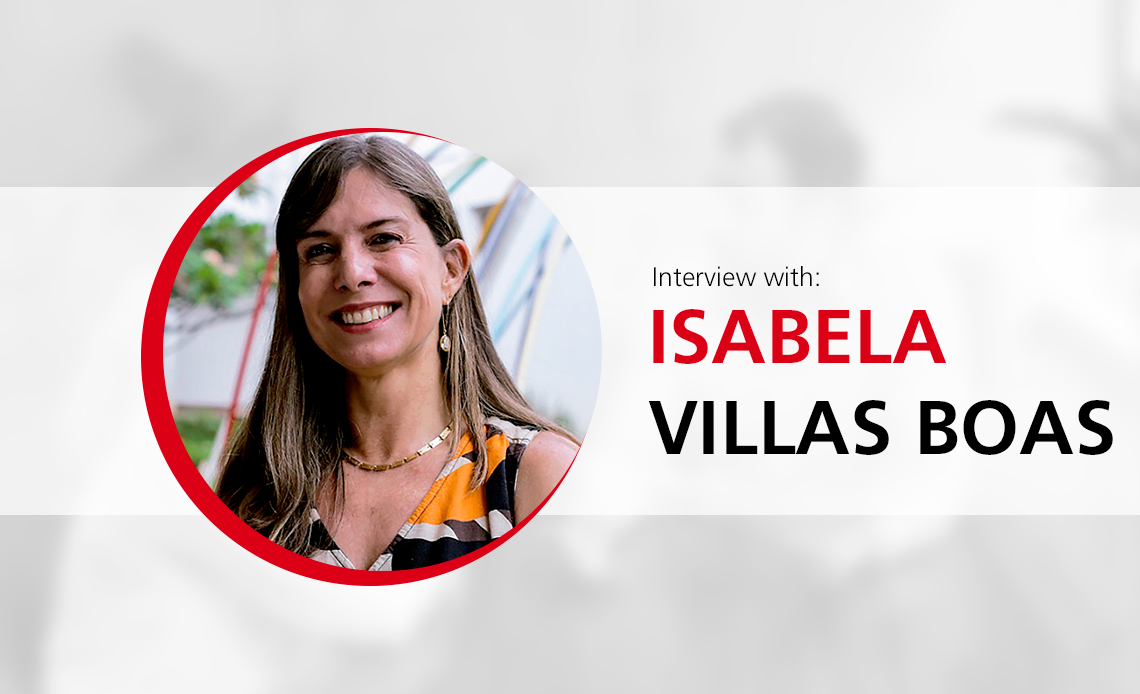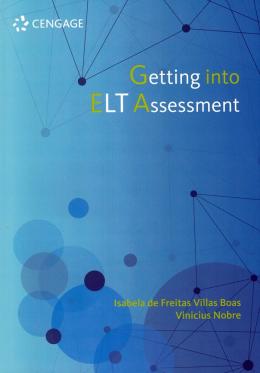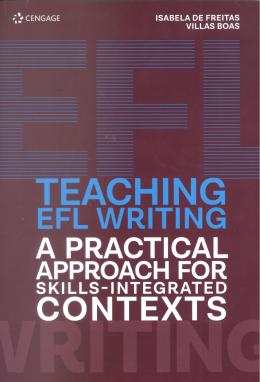
Jack Scholes: First of all, could you please tell us briefly a little about your background and how you became a teacher and then Corporate Academic Manager at Casa Thomas Jefferson in Brasília?
Isabela Villas Boas: I am what some call an “accidental teacher”. I have always loved English and, after finishing the advanced course at Casa Thomas Jefferson, I took all post‑advanced courses until the only one left was the Teacher Training Course. Thus, I decided to take it. Meanwhile, I was a Journalism major at Universidade de Brasília. After my second term of the six‑semester TTC program, I was invited to teach at CTJ. I hadn’t really planned to be a teacher, but I thought that it wouldn’t hurt to have a part‑time job while I was still going to college. Hence, I started teaching, and when I finished college and was about to quit teaching to start a career as a journalist, I was invited to be a course supervisor. I was already in doubt about which career path to follow, for I really loved teaching and working at CTJ, so the invitation encouraged me to stay and face the new challenge. After making a decision to be a teacher, I decided to invest in my professional qualification, so I got a Master’s Degree in TESL from Arizona State University and, later, a doctorate in Education from Universidade de Brasília. At CTJ, after working as a course supervisor, I became a pedagogical counselor to the General Academic Coordinator, Katy Cox, and when she decided to step down, she appointed me to replace her. She was already my mentor and continues to be one to this day. Today she is a consultant who works with teacher mentoring and observation.
JS: In your experience as an educational leader, managing large groups of teachers, what are some of the competences and skills that you look for in a teacher? What makes a teacher great?
IVB: Of course teachers need minimum requirements, such as being proficient in English, and have a college degree, and if this degree is not in Language Arts, some kind of TEFL/TESL certificate. There are essential subjects that they need to study in order to understand their field. They need to have a clear understanding of what language, learning, and teaching are and to be able to explain their teaching philosophy, based on solid theoretical background. Not only do they need to know how to teach, but they also need to be able to explain why they do what they do, that is, what informs their minute‑by‑minute decisions in the classroom. However, above all, great teachers need to be curious and open‑minded; they need to be lifelong learners of the subject they teach – English – and of what they do – teaching practices. They need to be informed of current trends in education and to be willing to try out new approaches and take calculated risks. Also, teachers today need to work on their digital literacy skills, not only to know the never‑ending new tools, but, most important of all, to know how to use these tools in order to help their students reach the learning objectives more effectively. In sum, great teachers think primarily of their learners and of how they can involve them in a unique learning experience.
JS: You have been involved in teachers’ associations for several years, making relevant contributions to the ELT community in Brazil. What do you think has changed in the professional development initiatives for teachers? What still needs to change?
IVB: Yes, it is true. I was one of the editors of Tesol’s NNEST‑of‑the‑month blog for five years and I’ve been involved in the local and national BRAZ‑TESOL for many years now. Throughout these years, I have noticed a great increase in the number of teachers involved in these associations and a big growth in the number of BRAZ‑TESOL chapters and special interest groups. This is a great indicator that the association is attending to local and specific needs, and not only global ones. However, it is still the same old people who, at the end of the day, volunteer and get things done. I wish we could have a greater diversity of people involved, particularly teachers from the public sector. I know of many initiatives taking place, one of which is the creation of a public‑school‑teacher special interest group. I hope it helps bring public school teachers closer to the association. Also, with this pandemic, local chapters are holding their events online, which is bringing people from different places together. I see this as a very positive aspect of this moment and that can help us become more inclusive in the future. Regarding teacher development opportunities, I have seen an exponential growth of initiatives. Publishers have been holding more events, and now with the bilingual programs, there have been many more CPD opportunities in this field as well.
JS: In Brazil there seems to be an increase in the number of digital influencers and youtubers teaching English. How do you assess this trend? Why do you think students have been investing in this type of learning? Is this online trend the future of ELT?
IVB: As a matter of fact, this is not new at all. These miraculous solutions to learning languages have always been around, in different formats. In the past, it was the collections of tapes, then DVDs, and now we have the YouTube channels, Instagram and Facebook lives, etc. There were also the “How to say everything in English” guidebooks in the past. Of course, technology has made the videos fancier and the digital influencer trend has led many of these YouTubers to become famous. Most are great communicators and entertainers. However, few people are able to learn an additional language like this, just watching videos, in a kind of self‑taught way. Most students need a plan of study and a facilitator. Interaction is also key to learning, and we all know that; it is essential in any kind of learning, but for languages, interaction is even more important, as is feedback on production. Thus, I doubt it that someone will go from zero proficiency to, say, a C1 level in the CEFR following digital influencers and YouTubers. Anyway, these resources are wonderful for additional practice and I highly recommend that students seek opportunities to practice English outside the classroom. We have our own series of podcasts with English tips, but this is what they are, tips. They do not replace an English program.
The fact is that English programs have used active learning strategies for the past 20 year or more. Communicative language teaching brought these strategies to the forefront in ELT and they are definitely here to stay because the focus is on the learners and their active engagement in the learning process.
JS: New technologies, educational apps, the maker movement, active learning strategies, content and language integration: the list of new pedagogies and approaches is quite long. Do you think English language teaching is becoming more effective? How relevant are these innovations? Which ones do you think are here to stay?
IVB: Well, new technologies have always been a trend and most high quality materials incorporate them. Of course the technologies change, so there are always new technologies to incorporate, but, as a whole, our field has been effective in incorporating new technologies. However, they can’t be used without a clear purpose and they should always enhance the learning experience. If they don’t, they should not be used.
Active learning strategies are not new at all, but they have been repackaged for the K‑12 subject‑area classes, which have always been very traditional and teacher‑centered. The fact is that English programs have used active learning strategies for the past 20 year or more. Communicative language teaching brought these strategies to the forefront in ELT and they are definitely here to stay because the focus is on the learners and their active engagement in the learning process.
Content‑based language teaching took longer than it should have to be incorporated into English‑language teaching in Brazil. CBLT has been around for a long time as well, and it is the strongest version of communicative language teaching in the weak‑strong CLT continuum. I think it makes sense for schools to adopt CBLT or CLIL (Content‑Integrated Learning) in their curriculum as a means to teaching English by way of content rather than teaching English per se. An ELT approach requires that students be separated into levels and this is not always possible in a K‑12 school environment. A well‑implemented CBLT or CLIL approach can incorporate students with different levels of English and in larger groups.
The maker movement has contributed to education in general in the sense that it brings a new mindset to the teaching process and it involves active and hands‑on learning, which is what neuroscientists have proven to be effective. However, just like new technologies, maker activities have to be used to enhance the English learning process and not just because they are a trend and are fun. They need to be effectively incorporated into the curriculum, with clear language learning outcomes as well.
What all of these trends have in common is the focus on the learner and on the development of essential skills, such as creativity, cooperation, communication, multiculturalism, risk‑taking, tolerance, among many others. The problem is when only these skills become the focus and language learning becomes secondary, as I have seen happen.
JS: You have recently published a new book with co‑author Vinicius Nobre entitled Getting into ELT Assessment. Why did you choose to write a book about assessment? Why do teachers need to be assessment literate?
IVB: For my Master’s Degree in Teaching English as a Second Language, back in 1999, I wrote an applied project on the use of portfolios to teach second language writing. For my project, I did extensive research on second language writing and testing and assessment, especially alternative assessment. I also took a course on testing and assessment. Since then,
Our goal is for teachers to know the essentials of assessment so they can design better assessment systems or be better consumers of external assessments, making well‑informed decisions.
I haven’t stopped reading and researching the topic. My doctoral dissertation in education and literacy focused on how a process‑writing approach in L2 helps students become better writers in their L1. One of the stages of process writing that I particularly highlighted was peer revision – something at that time (2008) unheard of in L1 writing classes in Brazil. Peer revision is a type of alternative assessment, so again I focused on both writing and assessment.
After my doctorate, I had the goal to write a book on second language writing, but I wanted it to be really simple and practical, to provide a concrete framework with examples that could be easily adapted. I accomplished this in 2017. However, I still had my second topic, assessment, in mind, but I didn’t want to write the book on my own again. The only person I knew who could write this book with me was Vinnie because we wouldn’t have to negotiate world views or writing styles. We think very much alike and have had similar experiences.
Our goal is for teachers to know the essentials of assessment so they can design better assessment systems or be better consumers of external assessments, making well‑informed decisions. We start with the basic principles, we talk about standardized and classroom tests, and then we focus on the core of the book – authentic assessment and assessment reform. Ultimately, we want students to have positive memories of their assessments, contrary to what normally happens today.
JS: What are the latest trends in assessment that English language teachers need to be aware of?
IVB: I believe we are in the middle of a big paradigm shift in assessment. There are more and more educators questioning the validity of traditional classroom tests and of standardized tests. US universities are dropping exams such as the SAT. Many high schools are now doing standards‑based assessment, on a scale of 1 to 4, and universities are accepting this new grading system. Researchers have questioned the giving of zeros or taking points off for late work because non‑cognitive factors should not affect students’ grades. In sum, there is a lot going in regarding assessment reform and we discuss this in the book.
JS: Under the present circumstances, with the whole distance learning debate due to COVID‑19, many professionals and institutions seem to be struggling to maintain their assessment frameworks. What can you tell us about the impact that the pandemic has had in terms of assessing learning?
IVB: The pandemic and the emergency remote teaching that schools had to shift to made some more traditional assessment practices impossible to replicate and, in a sense, meaningless. Schools that administer tests with proctors and students sitting in rows, with measures to prevent cheating, couldn’t find a viable way to replicate this remotely. The whole idea is outdated anyway. Even if we are to administer tests, we need to work on integrity and honesty. There are also ways to transfer tests to an online environment and time the students, for example. However, the best schools and educators were the ones who saw this as an excellent opportunity to promote a paradigm shift. Some took small steps, transforming their tests into the take‑home type, in which consultation is allowed because the items require more than rote learning. Others took bolder steps, such as focusing on performance assessments rather than traditional tests. I saw a greater focus on helping students succeed and giving opportunities for retakes, working towards mastery. I really hope this trend survives the pandemic and is here to stay.
JS: What is the role of international proficiency exams in the ELT market in Brazil? Is there a positive washback effect in the teaching and learning process?
IVB: Brazil is an exams‑oriented culture and many students and parents value certificates of proficiency. The work market also requires them for hiring purposes or for bonuses. In a way, there is a positive washback effect especially in K‑12 schools because they are now aiming at making sure their students achieve a certain level of proficiency in English, and not just teaching about English. Thus, there is more accountability. However, what I, personally, do not approve of is this obsession with exams at the end of short‑term stages. I really don’t see a point in them. If the goal of the student is to achieve a C1 level, then they should take classes until they are ready for a C1‑level exam and take it. There is no real need to take an A2, then a B2 exam beforehand, unless this student is going to need it for some specific purpose.
JS: How would you assess the educational system in Brazil when it comes to assessment? What might prevent us from experimenting and implementing more modern frameworks?
IVB: Our system is, overall, very traditional and outdated. It is focused on the transmission model of teaching and the amount of content taught is overwhelming. There is very little focus on the development of skills. Of course, there are exceptions. Thus, it is very difficult to implement innovations in assessment. We really have to go one step at a time, and this is also something we discuss in our book.
JS: Finally, could you please offer some positive messages for ELT teachers and students in Brazil?
IVB: I know everyone is going through hard times, one way or another. We need to stick together, even if only virtually, and keep our network strong and supportive. For teachers, never have there been so many accessible professional development opportunities. Seize these opportunities. Keep developing. Keep your minds busy. All this will pass and we will learn great lessons from it.
THE INTERVIEWEE

Isabela holds an MTESL degree from Arizona State University and a doctorate in Education from Universidade de Brasília. She has been working at Casa Thomas Jefferson, a Brazil-US binational center, for 33 years and is currently the Corporate Academic Manager. She serves on the BRAZ-TESOL Advisory Council and supervises MA dissertations for the University of Birmingham.
Email: isabela.villasboas@thomas.org.br Twitter: twitter.com/isabelavb

Assessment may not be one of the most popular topics in teacher education courses, but it certainly impacts the teaching and the learning process in a very direct way. This book aims at introducing some key concepts about assessment theory, explaining how these concepts relate to English language teaching, analyzing traditional and more current assessment paradigms, exploring the necessary knowledge to design tests and other assessment tools, and refl ecting upon the role that assessment has in education. It is a book for teachers, academic coordinators, course designers and anyone who is interested in deepening their understanding of what assessment is and how it impacts education.

Este livro é direcionado a professores em formação ou professores já atuando no ensino de inglês como língua estrangeira/adicional em contextos onde as quatro habilidades são integradas e que tenham pouca ou nenhuma experiência teórica e/ou prática com o ensino de produção textual em língua inglesa.

